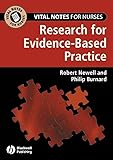Research for evidence-based practice / Robert Newell, Philip Burnard.
Material type: TextSeries: Vital notes for nurses | Vital notes for nursesPublication details: Oxford : Blackwell, 2006.Description: xiii, 242 p. : ill. ; 25 cmISBN:
TextSeries: Vital notes for nurses | Vital notes for nursesPublication details: Oxford : Blackwell, 2006.Description: xiii, 242 p. : ill. ; 25 cmISBN: - 9781405125628 (pbk.) :
- 9781405125628
- Research for evidence-based practice
- 610.73072 NEW
- RT81.5 .N46 2006
| Item type | Current library | Call number | Copy number | Status | Date due | Barcode | |
|---|---|---|---|---|---|---|---|
| Long Loan | TUS: Midlands, Main Library Athlone Nursing Collection | 610.73072 NEW (Browse shelf(Opens below)) | 1 | Available | 202964 | ||
| Long Loan | TUS: Midlands, Main Library Athlone Nursing Collection | 610.73072 NEW (Browse shelf(Opens below)) | 1 | Available | 202963 |
Includes bibliographical references and index.
SECTION 1: CONTEXTUAL MATERIALS:- 1. Introduction to nursing research for evidence-based practice:- Introduction--The scope of nursing research--Whose business is research in nursing?--Using this book to get involved in nursing research--Notes on person and gender--2. The Research Process: Organising your Research:- Introduction--The title--The abstract--Aims and objectives--A review of the Literature--The sample--Measures and materials--Data collection--Data analysis--Ethical issues--Financial issues--Writing the report--Publishing the findings--Timetable--Other issues--Organising your own research--Further reading--3. Choosing Methodological Approaches:- Introduction--When is a methodological approach fit for purpose?--Two different approaches to knowledge--Different broad methodological approaches and their appropriateness--What sort of questions for what general approaches?--Do we need to do research at all?--Further reading--4. Searching the Literature:- Introduction--Purpose of literature searches--Systematic reviews--Search process--Designing a search strategy--Components of a search strategy--Retrieval and inclusion criteria--Resources--Reporting your search--Further reading--5. Ethics of Nursing Research:- Introduction--Ethic committees and research governance--What can you do?--Further reading--6. Basic Concepts: Sampling, Reliability and Validity:- Sampling in research--Samples and populations--Sampling as an everyday pursuit--Samples and representativeness--Validity and reliability--Validity, reliability and sampling--Horses for courses--Further reading--SECTION 2: QUALITATIVE APPROACHES:- 7. Issues in Qualitative Data Collection:- Introduction--Sampling for qualitative research--Interviews--Questionnaires--Observation--Published work--Further reading--8. Case Studies:- Introduction--The case study as \'illustration\'--The case study as a research method--Drawbacks--Further reading--9. Ethnography:- Introduction--The stages of an ethnographic study--General methods used in ethnographic research--What should be observed? Analysis--Further reading--10. Phenomenology:- Introduction--Philosophical background--Applications--Methods--Further reading--11. A Pragmatic Approach to Qualitative Data Analysis:- Introduction--Thematic content analysis--Conclusion--Further reading--12. Limitations of Qualitative Research:- Introduction--Reliability and validity--Generalisability--The nature of human beings--Data analysis--Further reading:-SECTION 3: QUANTITATIVE APPROACHES:- 13. Sampling, Reliability and Validity Issues in Data Collection and Analysis:- Introduction--Representativeness, fairness and random sampling--Stratification--Sampling--Sampling, representativeness and external validity--Internal validity--Reliability--Validity of measures--Conclusions--Further reading--14. Cause and effect, Hypothesis Testing and Estimation:- Introduction--Cause and effect relationships in daily life--Examining cause and effect in health care--Variables--Hypotheses--Estimation--Further reading--15. Experimental and Quasi-experimental Approaches:- Introduction--True experiments--Quasi-experimental designs--Factorial studies--Conclusions--Further reading--16. The Single-case Experiment:-What is a single-case experimental design?--Why SCEDs?--The value of SCEDs--SCEDs in clinical practice--Types of single-case experimental design--Data analysis of single-case experiments--Shortcomings of single-case experimental designs--Conclusions--Further reading--17. Randomised Controlled Trials:- Introduction--What is an RCT?--Explanatory versus pragmatic trials--Further reading--18. Non-experimental Approaches:- Introduction--Descriptive designs--Casual comparative designs (comparative designs/ ex post facto designs)--Correlational designs--Correlation and prediction--Further reading--19. Surveys:- Introduction--Background issues in survey research--Instrument design and question construction--Administration--Enhancing response rate--Conclusions--Further reading--20. The Role of Statistics:- Why do i need to know about statistical tests?--What are statistics for?--Basic ideas: visual displays, levels of data and statistics--Descriptive statistics--Parametric and non-parametric statistical tests--Inferential statistics--Designs and statistics--Estimation and confidence intervals--Is this really all i need to know?--Further reading--SECTION 4: APPRAISAL, DISSEMINATION AND IMPLEMENTATION:- 21. Evidence-based Practice and Clinical Effectiveness:- Evidence and clinical practice--What are evidence-based practice (EBP) and clinical effectiveness?--The process of EBP in practice--The nature of evidence to support practice--Criticisms of evidence-based practice--Further reading--22. Critical evaluation of Research Reports:- Introduction--Reading the paper--Conclusions--Further reading--23. Writing a Research Report:- Introduction--Help the reader--General structure of the report--Basic style tips--Further reading--24. Getting Research into Practice:- Introduction--The nature of the change process--Effectiveness of interventions to get research innto practice--Barriers to implementation--Creating clinical guidelines: a change strategy in your organisation? --And finally. . . --Further reading.
The authors attempt to demystify the research process and evidence-based practice as well as examining their roles in improving patient care. Each chapter includes learning outcomes, exemplars and case studies.
